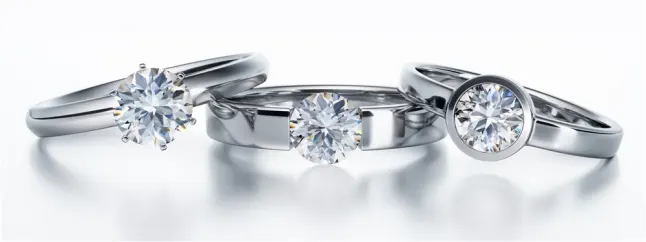General Jewelry Terms
Charm – an individual ornament that may be suspended on a bracelet or necklace. Often, charms have special significance to the wearer symbolizing people, places, events, etc.
Clasp – The closing mechanism for a bracelet or necklace. There are a ton of clasp variations on the market for you to choose from. The more secure options include lobster clasps and anything which includes an additional safety catch.
Diadem – A type of bejeweled crown.
Diamond Cuts – The final shape and ultimate facet count of a polished diamond. The goal in cutting diamonds is to create proportions and symmetry which maximize the beauty of individual stones. According to the GIA, beauty is evaluated utilizing three factors: “Brilliance”, “Fire”, and “Scintillation”. Cutters may choose from standard options or let their imaginations run wild with “fantasy cuts”. Here are a few of the more popular diamond cuts and what makes them special.
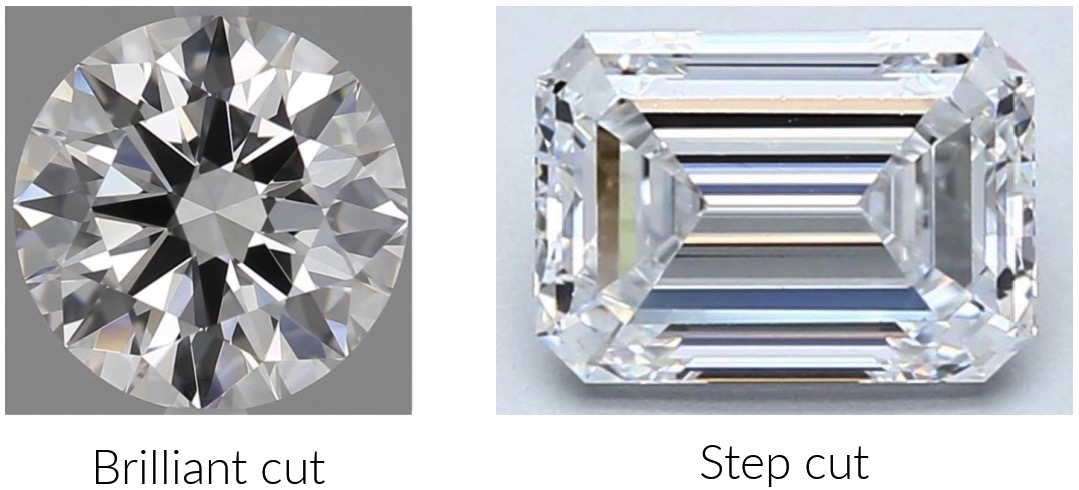
Brilliant Cuts – engineered specifically to maximize sparkle, brilliant cuts feature both kite-shaped and triangular-shaped facets paired with a table facet. Early examples of the brilliant cut are the Old Mine Cut and the Old European Cut. The Modern Round Brilliant Cut, which showcases 57 or 58 facets, as well as a perfectly round silhouette, dominates the diamond market. However, there are many modified brilliant cuts such as pear, oval, cushion, triangle for you to choose from.
Step Cuts – The key to step cuts are elongated, four-sided facets which line up next to each other creating a geometric effect. Popular step cut designs include the Emerald Cut and the Asscher Cut.
Mixed Cuts – Cutters and designers may create custom cuts that feature elements of both brilliant and step cuts.
Fantasy Cuts – Due to the hardness of diamonds, there are infinite ways to cut and wear stones. Designers can fashion any shape you can imagine! Letters, animals, flowers or elaborate geometric designs can all emerge from diamond rough.
Disclosure – The Federal Trade Commission requires that all diamond sellers clearly inform all buyers if their stones are, or are suspected of, being either synthetic or having undergone any treatments. Such treatments include, but are not limited to, heating, fracture-filling, and laser-drilling.
Encrust – To cover a surface in jewels.
Engraving – A message which is cut or carved onto the surface of jewelry (usually done inside a ring).
Facet – The individual polished surfaces of a cut diamond. Some standard cuts, like the Modern Round Brilliant, have a prescribed number of facets while others do not.
Filigree – a type of delicate metalwork which involves small wires interlaced with each other.
Hallmarks – Discrete distinguishing inscriptions on the metal of jewelry used to ensure that the buyer is properly informed about the makeup of the jewelry item. Hallmarks are used to indicate the artist/design company, the specific metallic content, the date of creation, and the country of origin.
Melee – Small diamonds which weigh less than 0.2 carats.
Milgrain – A decorative technique that uses tiny metallic spheres incorporated into jewelry design.
Mineral – An inorganic substance that has a unique chemical composition and repeating crystal structure. Diamonds and most other gemstones are considered minerals.
Mohs Scale of Hardness – A ranking system that describes the hardness (resistance to scratching) of various gemstones from the softest (1) to hardest (10). With a ranking of 10, diamonds are by far the hardest of all gemstones.
Polish – The quality of the surfaces of a cut diamond. Diamonds have the potential to showcase exceptional polish, however, poor polishing techniques and general wear-and-tear can result in imperfect surfaces. Imperfections include scratches, nicks, and even burns.
Proportions – The exact proportions of cut diamonds have a huge impact on the overall beauty of a stone. Depending on how the angles are aligned, diamonds may reflect sparkling light back to your eye or absorb it resulting in a dark and dull appearance. Different shapes have differing ideal proportions. GIA diamond reports feature an entire section that lists all of the individual proportions of the stone.

Setting – Referring to the casing which holds the stones.
Shape - The outline of the diamond (often interchanged with cut, even though they are different).
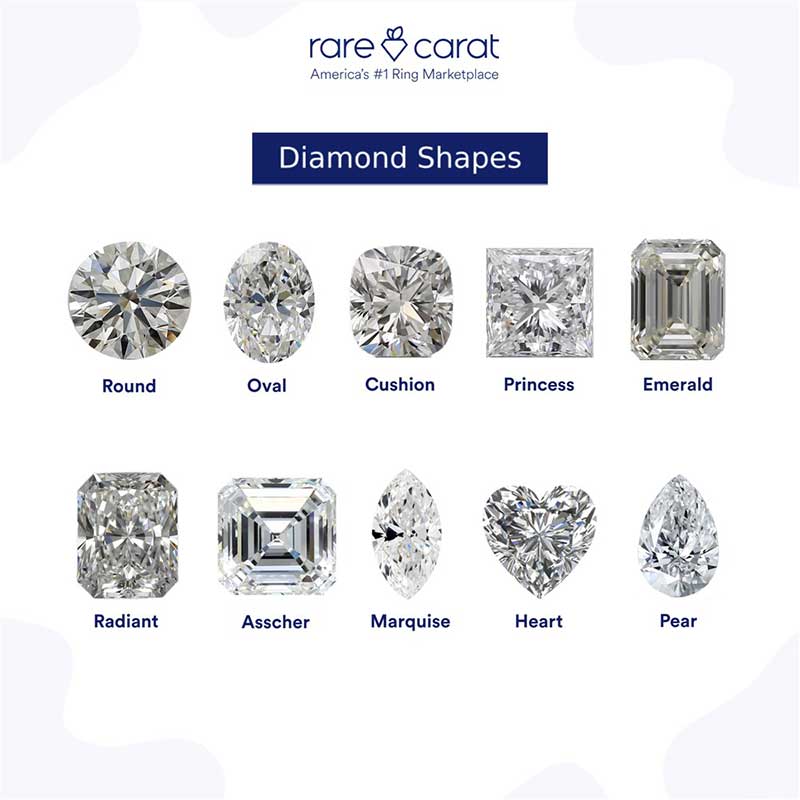
Symmetry – This refers to how the facets are shaped in relation to each other. Similar to the importance of the proportions of a diamond, symmetry of the facets is critical in creating the optimal light refraction and reflection.
Metal Terms
Alloy – A mixture of different metals into a single hybrid substance. Combining different metals results in an alloy with specific attributes. Factors such as hardness, toughness, and color are among the characteristics which may be manipulated.
Finishes – Depending on how metals are treated, there are a number of distinct appearances that can be created.
Florentine – Associated with labor-intensive Italian craftsmanship, tiny crosshatching on the surface of the metal yields a soft, almost fuzzy look.
Hammer – An almost dented appearance that can be made in high or low polish.
Matte/Satin– A non-reflective, low polish look. It may be created by imprinting minute pits or scratches on the surface of the metal by abrading the metal or subjecting it to a chemical reaction that affects the surface of the metal.
Gold:
An inherently soft metal, gold is often alloyed with other metals in jewelry to prevent it from bending, scratching or breaking. Depending on which metals are alloyed with gold, various hues are generated. Silver, copper, tin, nickel, platinum, palladium, and zinc all are commonly mixed with gold.
- Karat – The purity of gold is divided into twenty-four parts where 24K is pure. However, as 24K is so soft, it is unusual to see it in jewelry. If you do, most likely it will be in the form of earrings. Popular alloys in descending order of purity are 22K, 18K, and 14K.
Color:
There are many color possibilities for gold alloys. Here are some of the most popular:
Yellow– The natural color of gold.
White – This is achieved by incorporating alloys such as nickel, zinc and copper. This was first used in jewelry beginning in the late 19th century. If you have a nickel allergy, white gold may cause you to have a reaction and you should stick with platinum or yellow gold. Will need rhodium plating every few years to keep it looking bright white.
Rose – The pink-hued alloy comes from the presence of copper and silver. It also was developed in the 19th century.
Green – Again, copper is often responsible for this color of gold.
Gold Filled/Gold Plate – Two commonly confused terms, “gold-filled” and “gold-plate” are two distinct techniques. Gold-filled jewelry has an outer layer of gold laid over another metal. Gold-plate jewelry has only a thin film of gold applied on top. Gold-plate may wear away so rings or bracelets should not be subjected to daily wear. A hallmark should be present to indicate if your jewelry is either of these.
Vermeil – A layer of gold over silver and perhaps other precious metals. Vermeil usually refers to a covering of 10K or 14K gold over silver.
Platinum:
A difficult metal to manipulate and refine, platinum became a popular option for jewelry at the end of the 19th and in the early 20th centuries. Because it can be shaped into thin, yet strong, wires, platinum is a versatile white metal that can be formed into delicate and lacy designs. It also never needs rhodium plating to keep it bright white as it's that color when it comes out of the ground.
Silver:
Previous to the use of white gold and platinum, silver was the dominant white metal option for jewelry until the 19th century. It's not recommended for diamond jewelry since it is not strong enough and you could lose your stones.
Diamond Terms
Color – The color of diamonds is graded on the “normal color range” scale developed by the GIA in the 1950s. This system ranks colorless diamonds from D-to-Z where D represents purely colorless stones and Z signifies yellowish, brownish, or greyish stones which are just shy of having enough color to be considered “fancy-colored”. Each letter in this scale represents the smallest perceptible change in color from its neighbor when examined by a trained professional under specific lighting conditions. The system is divided into five categories: Colorless, Near Colorless, Faint, Very Light, and Light. Considering color on its own, stones higher up on the scale carry greater value than stones at the lower end of the spectrum with D color diamonds having the highest worth.
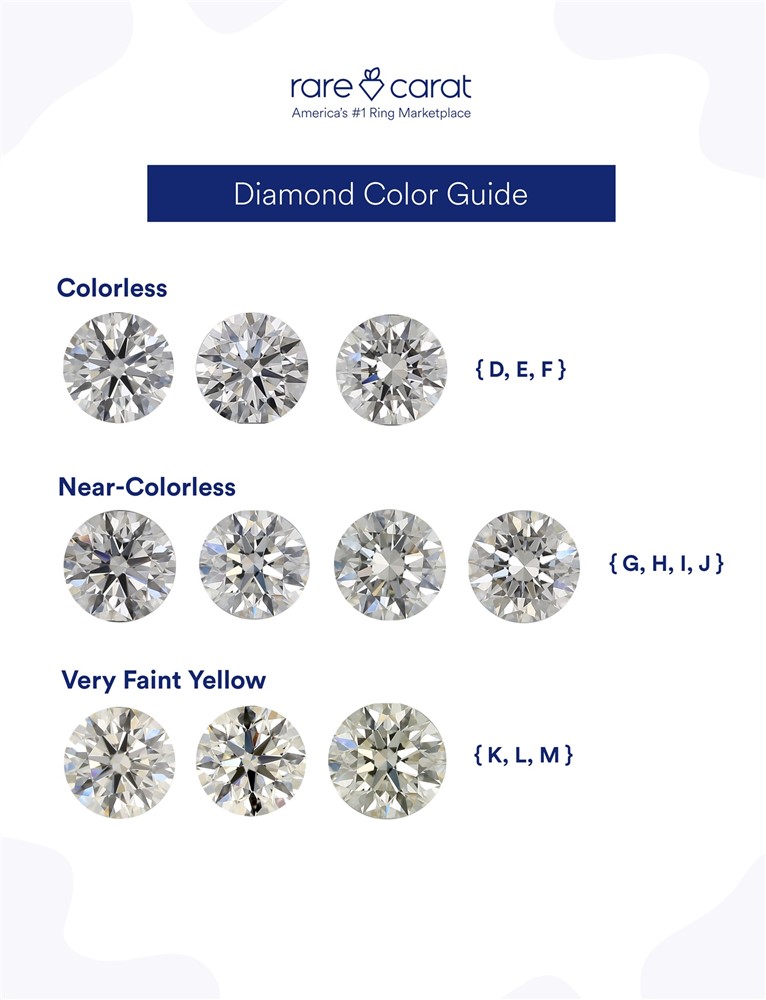
Clarity – The Clarity section explores how clean diamonds are. Natural diamonds grow very slowly deep in the Earth’s crust. Often, during this growth process, they will swallow impurities that happen to be near them or, alternatively, the pressure on the stone may vary, leaving behind graphite particles. Similarly, synthetic diamonds may also swallow impurities present in their growing environments. Once within the stone, these elements are called “inclusions”. Diamonds are sorted into six categories when it comes to clarity: Flawless (F), Internally Flawless (IF), Very Very Slightly Included (VVSI), Very Slightly Included (VSI), Slightly Included (SI), and Included (I). The ultimate rating depends on five factors that describe how the inclusions appear: Size, Number, Location, Relief and Nature. Considering clarity alone, the cleaner the stone, the higher the value with Flawless stones being both rare and costly.
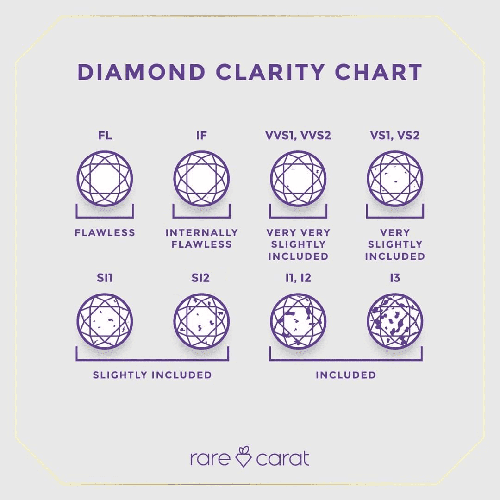
Cut– The Cut grade has to do with how well the facets of a polished diamond reflect the light. This all has to do with proper proportions and symmetry based on the shape of the stone. Gemologists evaluate the cut based on three factors: Brilliance, Fire, and Scintillation. Brilliance describes the pattern of light and dark flashes seen while looking at the diamond face up. Fire is the pattern of rainbow colors. Finally, Scintillation is the overall pattern of sparkle. Cut is graded as Excellent, Very Good, Good, Fair, or Poor on the GIA Report.
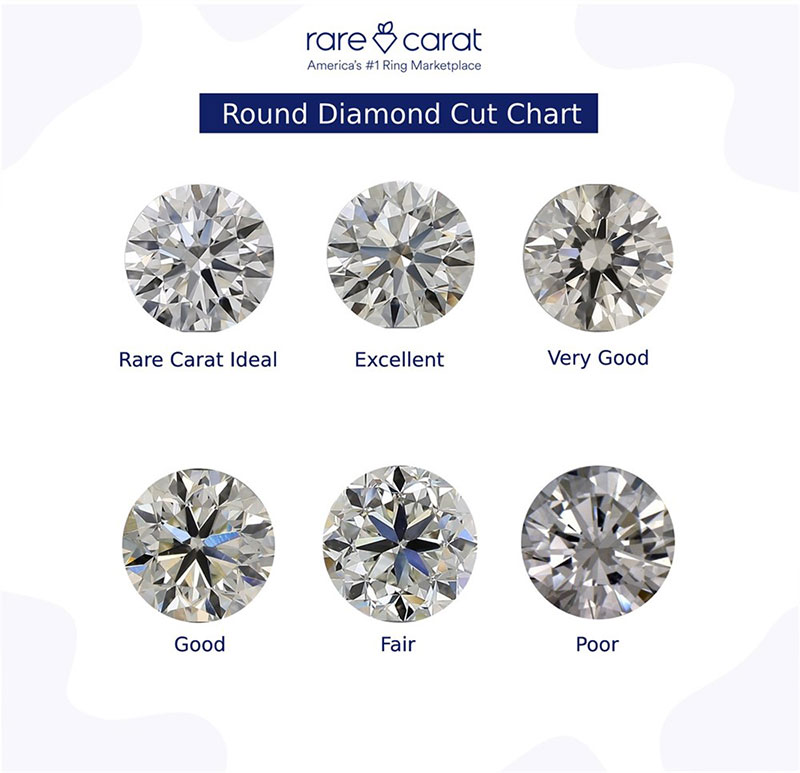
Carat – Carat just describes how much the stone weighs. The bigger the stone, the higher the cost. With jewelry that features multiple diamonds, you may see the abbreviation “tw”. This is short for “total weight” and refers to the cumulative weight of all diamonds present in the design. Note that the term “tw” may be used to describe all different types of gemstones. However, it only will apply to one gemstone species at a time. For example, you may find a ring that features one carat “tw” of diamonds and two carats “tw” of sapphire but you will NOT see this ring described as having three carats “tw”.
Cleavage – we think of diamonds as being the hardest of all gemstones. This is true, however, the molecular structure of diamonds includes a vulnerable “cleavage plane”. Cleavage planes describe a weak direction in a crystal structure that is susceptible to splitting if it is hit directly. This is usually not a serious concern for diamond jewelry owners because cutters know to orient stones so that the cleavage plane is protected by the stone’s setting.
Culet – the bottom point of a diamond where the pavilion facets come to a peak. This point may or may not feature a culet facet which flattens that point. Leaving the point intact may, depending on the setting, leave it vulnerable to damage. Alternatively, having too big a culet facet can result in an eye-visible circle seen through the top table facet.
Fluorescence – Light produced when stones are exposed to ultraviolet or x-rays. Approximately one-third of natural diamonds exhibit blue fluorescence to some degree. Synthetic diamonds may fluoresce various colors depending on how they were synthesized.
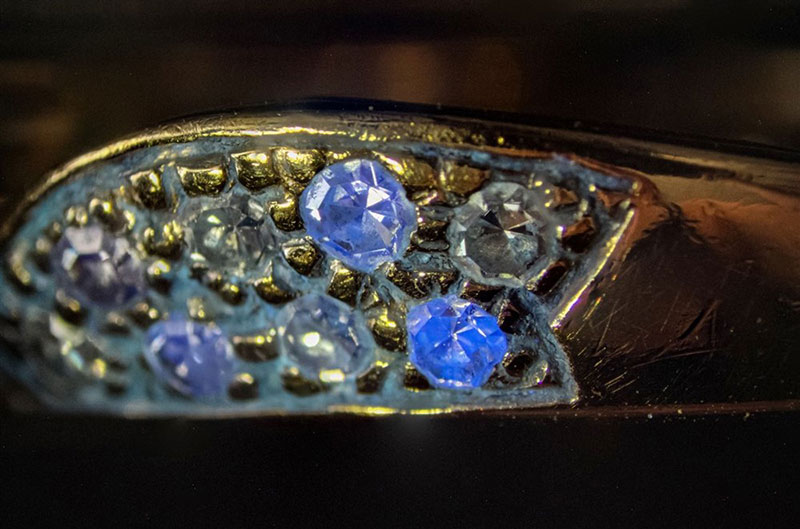 Photo Credit: Kimberly Abruzzo
Photo Credit: Kimberly Abruzzo
Girdle – The widest point of the circumference of a diamond. Depending on the cut of the stone, they may be very thin or thick. Generally, you want to look for a thin to thick girdle that is thick enough to be durable but not add extra, unseen carat weight which will increase the price of the stone.
Laser-Inscription – Messages can be imprinted onto the surface of a diamond via lasers. If you send in your diamond for a GIA Report, they may laser-inscribe the report number onto the girdle of the stone. This is particularly helpful if you misplace the physical report and need to look up the details of a stone online. Some individuals request that the GIA also spell out a note, reference an important date, or add a symbol onto the girdle (for an added fee).
Simulants – Diamond simulants are stones that look like diamonds but have different chemical makeup. Because they are different chemically, they do not have the same characteristics that diamonds do such as supreme hardness. Further, their special cocktail of Brilliance, Fire and Scintillation may also be slightly different. However, if you are on a budget and looking for a big colorless stone, a simulant diamond may be the way to go! Some common diamond simulants are Cubic Zirconia (CZ), Synthetic Moissanite, Zircon, and even glass!
Synthetics – Diamond synthetics are stones that are chemically identical to natural diamonds but were grown artificially at an accelerated pace. There has been mounting interest in synthetic diamonds for two main reasons: the finite amount of natural diamonds available to be mined and popular interest in low-cost genuine diamond options. Research has yielded two main synthesis processes: High Pressure, High Temperature (HPHT) and Chemical Vapor Deposition (CVD). Both processes have predictable outcomes and the most recent synthetic material looks so natural that it requires advanced testing to be separated from natural material. The GIA will laser-inscribe synthetic diamonds as well as clearly noting it on the report. Also, according to the Federal Trade Commission, sellers must have “clear and conspicuous disclosure” when it comes to marketing their diamond synthetics. This means that sellers must use terms like “laboratory-grown” and “laboratory-created”.
HPHT – Basically, HPHT mimics the natural growing environment of diamonds in the Earth. A carbon source is exposed to high temperatures and high pressure within a crucible for a specific length of time and diamonds develop! Technologies continue to advance, and scientists are now able to produce low-cost stones of many different colors with high clarity grades.
CVD – This method is nothing like the natural growing process and involves material that grows out of an aerosolized soup of carbon and other chemicals. Rather than expanding outward like the growth of HPHT stones, CVD diamonds grow in layers, yielding a flat rough product. Once polished, it produces a beautiful diamond that looks the same as an HPHT or natural.
Table Facet – The table facet is the large flat plane on the top of a stone.
Treatments:
Coating – glazing the outside surface of diamonds is a safe and relatively easy way of inducing apparent color modification. Unfortunately, it is not permanent and is susceptible to scratching or other types of damage.
Fracture Filling – The introduction of a molten glass-like substance into existing fractures within the diamond. Filling voids can greatly reduce their appearance, however, fillers may be damaged by jewelers doing repairs, cleaning, or resetting stones. If you know that your diamond is fracture-filled, always let your jeweler know before they do any work on, or around, the stone!
High Pressure/High Temperature – A completely separate process from HPHT diamond synthesis, mature natural or synthetic diamonds (CVD) may be subjected to heat on its own or coupled with a high pressure environment. This may whiten the color of some stones or, alternatively, create a green or yellowish-green color. Because of the stress that the HPHT treatment puts on the stones, it is advisable to only attempt this on stones with high clarity grades that don’t have significant inclusions which may expand or melt. It is a stable process.
Irradiation – Diamonds may be exposed to radiation naturally while buried in the Earth or may be artificially subjected to it, usually after being faceted. Radiation causes diamonds to take on a green or bluish-green hue. Extreme heat, like that produced by a jeweler’s torch, may alter the hue of such stones.
Laser Drilling – solid inclusions within diamonds may be removed or bleached to a less noticeable color by using a laser to drill a hole down to the impurity. These holes are thinner than a human hair and can be used to introduce an acid or other agent to alter or remove the inclusion.
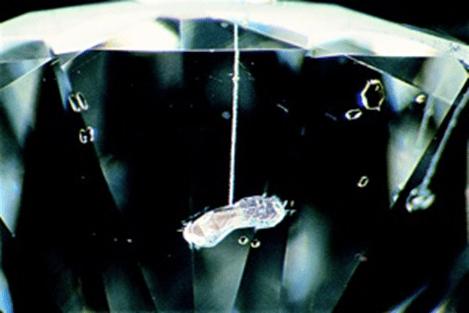
Diamond Setting Terms
There are a ton of ways to set diamonds! These different methods are used to highlight different attributes of individual stones and create unique designs.
Bead – A small amount of metal is lifted from the body of the setting and bent over the girdle of the diamond. This is a relatively flat setting that won’t snag.
Bezel – A very secure option suited for jewelry that will see heavy wear, bezel settings surround the girdle of the diamond with metal. This protects the stone from most possible sources of damage and holds it in place so risk of losing the stone is minimal. Bezel settings are a beautiful option appropriate for the engagement rings of individuals who work with their hands.
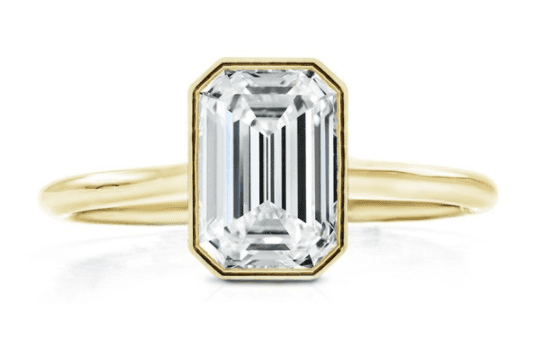
Channel – A type of setting used mostly for melee stones, diamonds are lined up in a groove with no metal separating the stones.
Cathedral – For those who want to showcase their diamonds, cathedral settings lift stones for a high-profile silhouette. This is a showstopping design, but, may be impractical for some.
Illusion – Intended to make center stones look larger than they are, illusion settings use extra metal to create an exaggerated diameter around the girdle of your primary diamond. This excess metal is often patterned to imitate the shine of diamonds from a distance making the jewelry appear much more substantial.
Invisible – The explanation is in the name! Invisible settings use clever metalwork under stones so that they sit next to each other without any metal showing through. Keep in mind - they are difficult to repair, so be sure to speak with your jeweler prior to purchase.
Pave– Derived from the French word for “paved”, pave settings set diamonds in rows carving a nest for them directly into the mounting and employing small prongs.
Prong – A popular setting style, prongs use small pieces of metal, originating from under the stone, to reach over the girdle and hold stones in place. Depending on the design, single stones can be held by two or more prongs. Some styles use single prongs to hold multiple stones.
Sets – Rings, particularly engagement and wedding bands, may be designed to be worn in pairs. These may sit flush against one another, may include a gap, and may or may not be connected to each other.
Tension – Stones are suspended between the metal of the mounting relying on pressure to hold them in place.
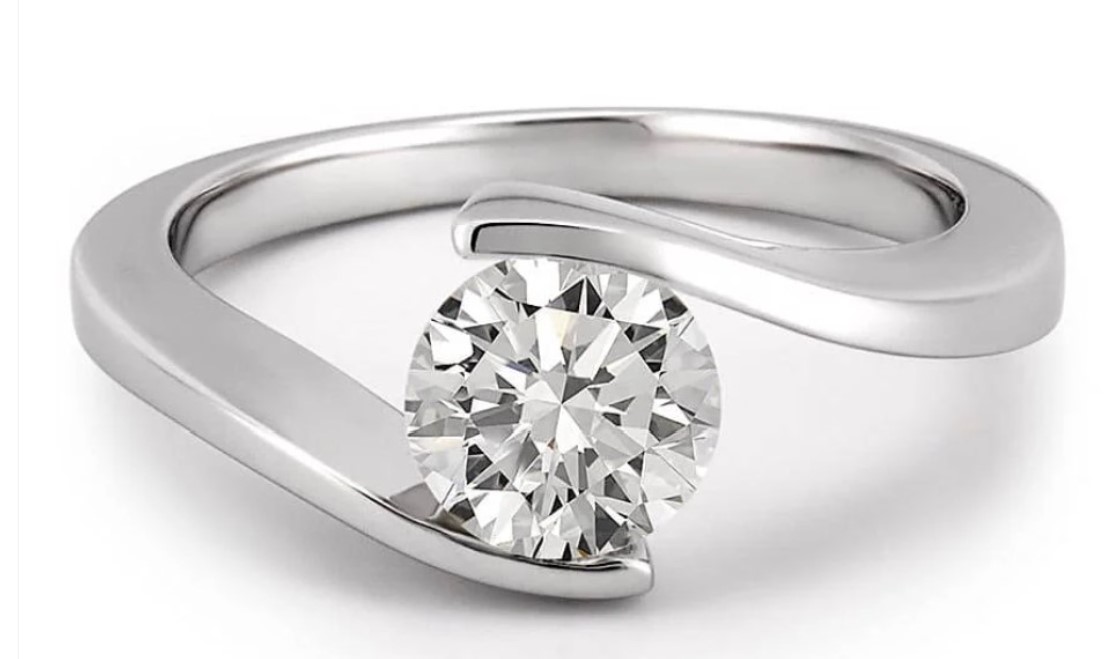
Earring Terms
Types of Backs:
Clip-on – Created for individuals who lack piercings, clip-on backings rely on pressure created by springs to keep earrings in place. Note that these will not be as secure as settings for pierced ears (and they often hurt after a while).
Friction/tension - The most common earring backing, posts have a small notch at their end over which slides a backing. Simply pull the backing to release.
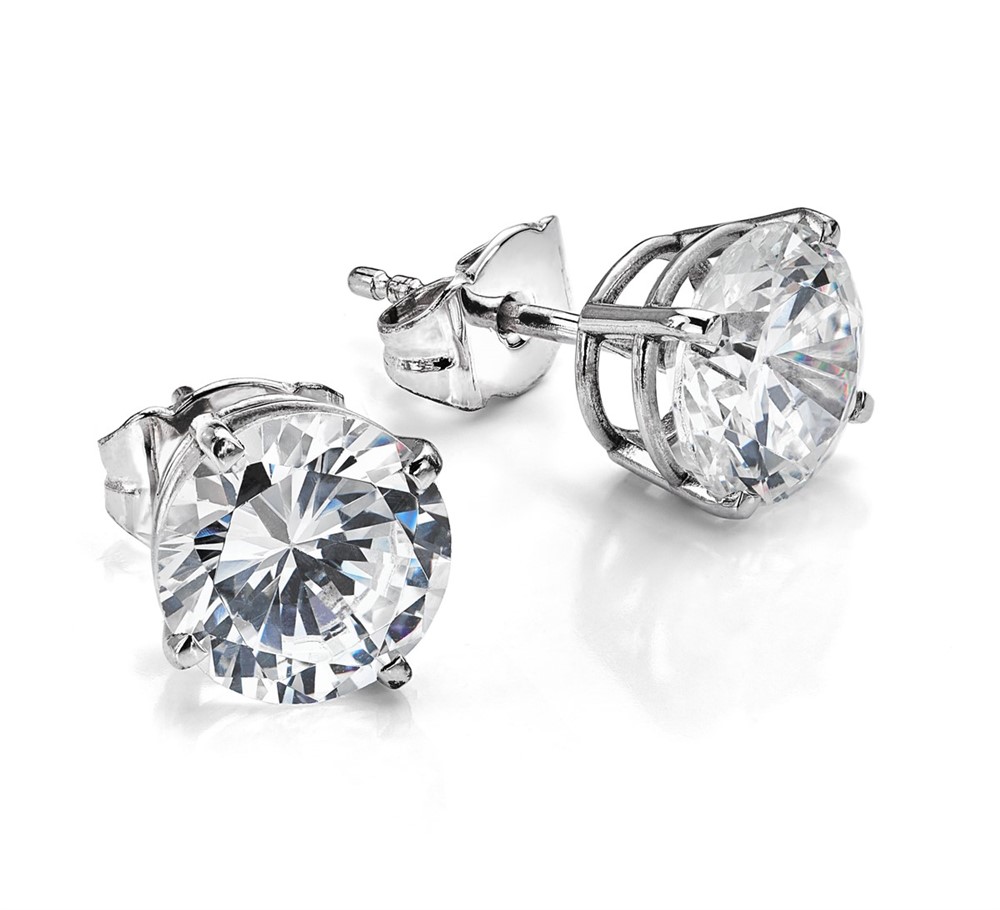
Hook – hook enclosures utilize a long post that arches down behind the ear and may not require a separate backing component (although they are certainly recommended for pricy earrings!). The arches can be fashioned in multiple different shapes, some of which have specific names such as “fish” or “shepherd” hooks.
Lever settings - An all-in-one design that features both a post and an attached movable metal securing component. The movable part swings up behind the ear to meet the post, thereby locking the earring on.
Locking back - Definitely one of the most secure earring backs out there, it consists of a little disk that you have to squeeze on both sides to lock into place on the post. It can be difficult to use, especially if the wearer has long fingernails.
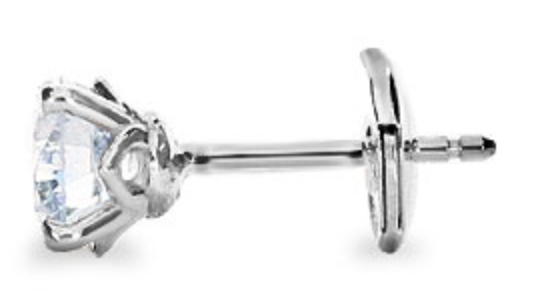
Omega settings – Similar to lever settings, omega earrings are a single complete unit. A loop, shaped like the Greek letter “omega” swings up behind the ear and over the back of the post to secure the earring. These are a very secure option suitable for high-value jewelry.
Screw back/ Threaded post – Similar to friction/tension settings, this option utilizes a post with grooves and a separate backing component. The backing twists onto the post and can be secured as tightly as is comfortable for the wearer.
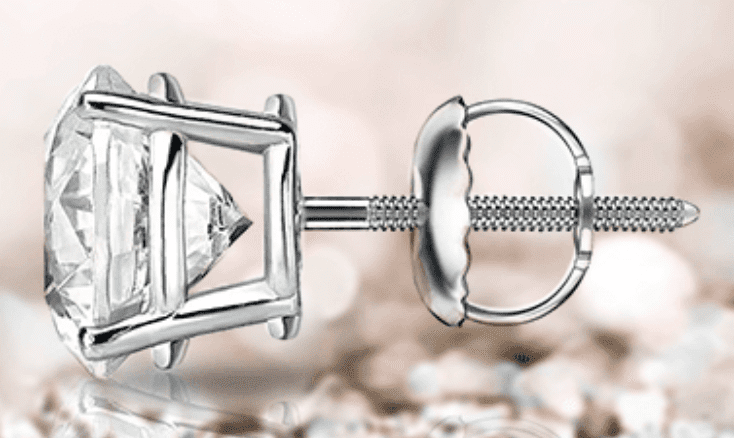
Hoops - Hoop earrings hang from posts to create a circular, oblong, or abstract shape under your ear. They may be any size and the ends may or may not connect to enclose the shape.
Huggies – Essentially tiny hoops, huggies fit snugly around the ear lobe.
Jacket – A separate and removable ornament that hangs from the post of an earring.
Post – the metal part of the earring which fits through your piercing.
Stud – A simple, usually small, design that sits on top of your piercing without additional ornamentation dropping off the post. Studs may or may not feature stones.
Necklaces/Pendant Terms
Bib – A showstopping design thousands of years old, bib necklaces cover the upper part of your chest.
Choker – 14-16 inches. These necklaces sit at the base of your neck and settle on your collar bone.
Collar – 12-13 inches. The shortest of all necklace options, collars sit flush against the body of your neck.
Lariat – a long necklace that does not connect to itself to form a circle. Rather, it is crafted as a rope that is intended to be wrapped around the neck. Lariats may include a clasp.
Matinee – 22-24 inches. A bold look that will stand out in a crowd!
Opera - 30-35 inches. Originally intended for formal events – like the opera! – this length is fancy, unusual, and eye-catching.
Pendant – this term refers specifically to an ornament that is free to move along a necklace. Some pendants are suspended from the necklace by a loop-shaped connector called a “bail” or, alternatively, the pendant may be directly threaded onto the necklace via a “slide” design. Depending on the design, pendants may or may not be removable.
Princess – 18-20 inches. A hassle-free and versatile length that can be appropriate for both causal and professional settings.
Riviere – A design that is at least two hundred years old, the term “riviere” comes from the French term for “river”. Riviere necklaces feature a stream of diamonds or other gemstones seamlessly encircling the neck.
Rope – 35+ inches. Super long and dramatic, ropes are all about drama and attitude!
Station – jewelry that features decorations fixed at regular intervals along the necklace.
Chain Information – Depending on the type of necklace/pendant you want to wear, chain selection can be an important consideration. Some of the more traditional options available on the market include rope, box, cable, mesh, curb, and cord.
Ring Terms
Anniversary Ring – A ring given to a spouse celebrating the anniversary of their marriage.
Cluster – Just as it sounds, cluster rings feature bundles of multiple gemstones.
Engagement Ring – A ring usually worn on the fourth finger of the left hand symbolizing commitment and the promise of a future marriage. Although there is no universal design for an engagement ring, they often feature one or more significant diamonds.
Eternity Ring – A ring that features a row of gemstones encircling the entire band.
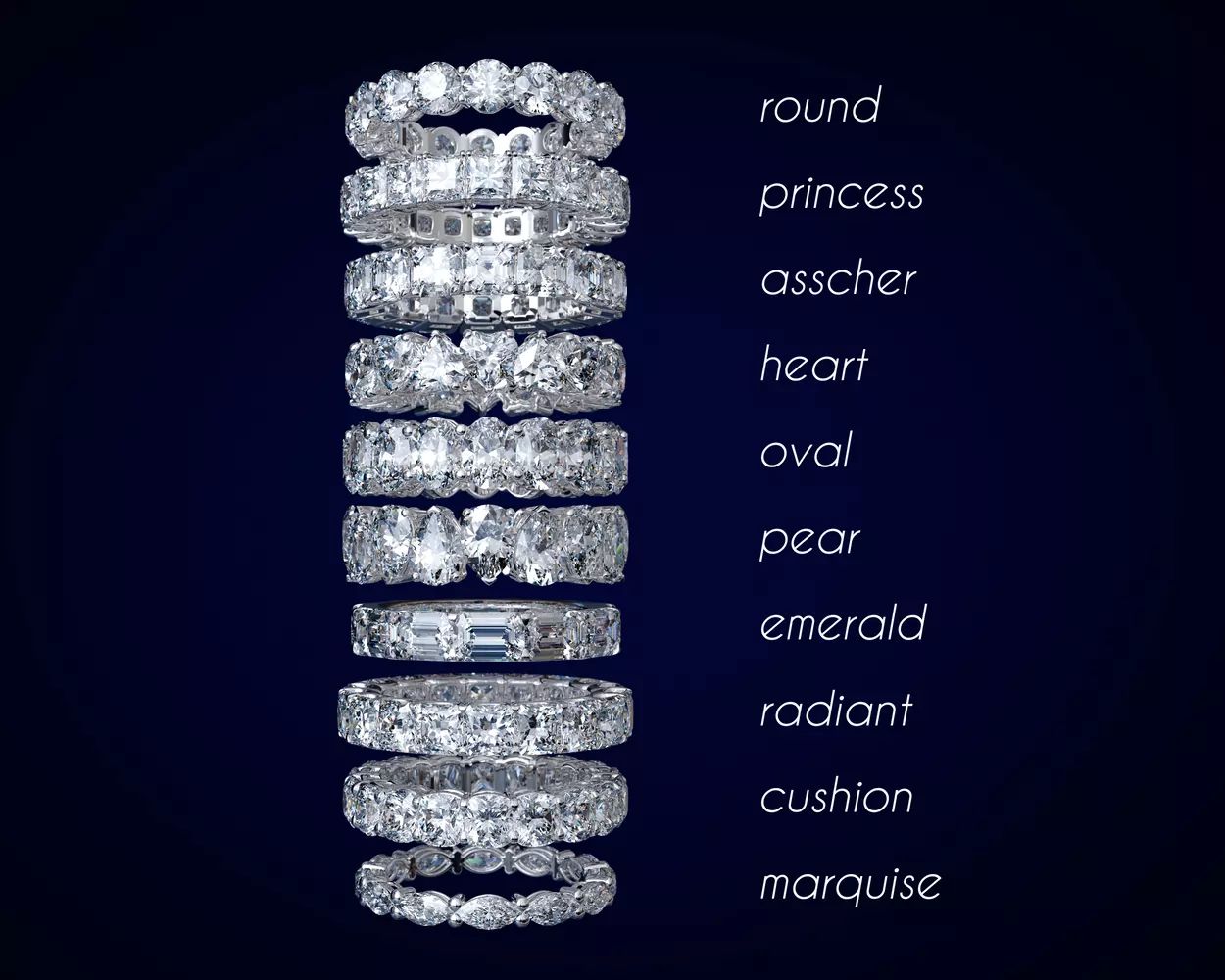
Halo Setting – Halo settings involve surrounding a central diamond(s) with smaller stones. This both makes the center stone(s) appear larger and adds lots of extra sparkle!
Solitaire – Credit for popularizing this design goes to Tiffany & Co. who introduced their solitaire engagement ring in 1886. Here, a single center stone set with prongs on a plain metal band. This has remained one of the primary engagement styles since its debut!
Wedding Ring – A ring symbolizing the commitment of marriage which is worn behind the engagement ring closer to the body. Wedding ring designs tend to be simpler than their engagement ring counterparts featuring fewer/smaller diamonds.
